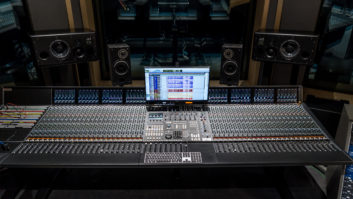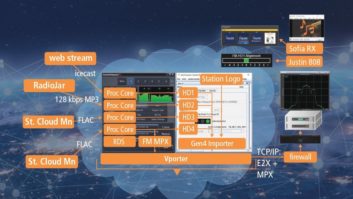I have written about the evolution of broadcast technology in this column for quite a few years.
Whereas the need for tape machines, turntables, and to a large degree, vacuum tubes has long since disappeared, the need for audio processing and all its associated benefits is as strong as ever.
We all know the circuitry inside a typical audio processor is nothing like it was 25 years ago — but its function, and the results desired, remain unchanged. That”s the topic this time: Over-the-air audio processing for AM and FM.
CONSISTENCY IS KEY
It is often said that on-air processing is used to generate a signature sound for a radio station. What that really means is the station should always be recognizable to any listener at any time, simply by what they hear coming out of speakers. In order to do that, all the elements heard by a listener should be consistent in their loudness and tonal quality (meaning roughly how each element is EQ’d).
Those of you who are old hands at audio processing know that what I’m saying is much easier said than done.
The motto “we’ll fix it in the mix” is sometimes applied in this case: Let the on-air processor fix whatever issues are evident in the program audio content.
In my experience this is not a good approach. While adjustments to an audio processor can give a station consistency, along with some other characteristic that makes it sound recognizable, in the end better results are achieved if effort is put into having each element that makes up the program content sound as consistent as possible, before they go in to an over-the-air processor.
In a future article on audio processing around the station, we’ll get in to details on achieving those goals. Separately, we’ll talk about processing for streaming media.
ON-AIR PROCESSING: FM
Standard features for an FM on-air processor include wideband AGC, multiband AGC, multiband limiting, HF limiting and built-in stereo generator with limiting.
Audio processing presets are standard, as well; the end-user is given access to many (if not all) of the processing parameters, so that he or she can modify then to suit the taste and requirements of programming and/or engineering. These presets are designed to work right out of the box but do afford the end-user the opportunity to give the sound of the station some sort of quality or characteristic that is recognizable.
A relatively new feature for many is an AES output, sampled at 192 kHz, that represents the composite audio feed that heretofore has only been made accessible via an unbalanced, low-z source, on a BNC connector. Many will also have a parallel processing chain, with a wider audio bandwidth, and no HF limiting, that ultimately is used for streaming media or digital radio. Devices such as this all either support HTTP or use a proprietary GUI accessed via IP.
Like transmitters and console/routing systems, there is a huge amount of brand loyalty among radio engineers when it comes to choosing on-air processing. I think you’re doing your station a disservice if you do not give an audition to a different brand of processors, at least every couple of years.
WHAT’S ON THE MARKET?
One manufacturer offering FM/HD processing is BW Broadcast. Their DSPXTRA-FM is another single rack unit device, with a built-in Ariane RMS leveler, parametric and shelf bass management, multi-band program-dependent limiting, and multi-band look-ahead limiting. It features a DSP-based stereo generator with composite clipping control and a pilot protection filter. Analog and AES inputs/outputs standard.
The DSPEXTRA comes with a set of presets, a real-time clock to switch between said presets as necessary (day-parting) and an A/B preset swapping function that allows the user to determine which preset he or she likes best.
Control is done via the front-panel interface, an RS-232 interface on the rear panel or via IP, of course.
Inovonics is active in the FM/HD audio processor space. The DAVID IV is the fourth-generation processor in the DAVID series. Just one rack unit, of closed-box design (no fans or heat-sinks needed) it’s 100 percent DSP-based, with AGC, five bands of dynamics compression and equalization, bass and stereo field enhancements, and Inovonics’ proprietary PIPP (Polarity Independent Peak Processing) limiter. Included also is a stereo generator (with two composite outs) with internal metering and a summing input for adding an RDS subcarrier to the composite output.

One interesting characteristic to note is that DAVID IV will pass audio in less than a second after a boot.
With an optional drop-in board, DAVID IV can provide up to 9.999 seconds of delay for HD radio broadcasting purposes. It also comes with 25 factory presets, and has room for 20 custom, shareable user presets. Audio inputs/outputs are available as balanced line level or AES-3. Remote control and access are accomplished via IP; the supplied software allows remote setup and operation of the DAVID IV using any Windows PC (XP or later). A front-panel graphic display and jog wheel allows for menu-guided in situ setup and operation. LED-bar displays indicate in/out levels and audio processing action.
Omnia (part of the Telos Alliance) has an extensive line of on-air audio processors.

The Omnia.9 makes use of multi-stage wideband AGC with side-chain equalization for gain riding over a 36 dB range, along with a separate bass processor. It uses from 2 to 7 bands of multiband AGC and limiting. It has a feature Omnia is calling “Auto Pilot,” which “suppresses the 19 kHz stereo pilot during mono material for a radical 12 dB signal-to-noise improvement.” Omnia.9 has onboard Omnia Direct, the feature allowing MPX composite base- band over AES.
Omnia .9 has a feature known as “undo” which corrects over-processed source material. It features a low-latency independent studio output for talent monitoring, and patch points within the signal path allow monitoring of audio as it passes through various input, output, and processing stages. These patch points are also available on the built-in oscilloscopes, spectrum analyzers and RTA instrumentation to provide a corresponding visual reference. Patch points can be monitored locally or streamed through the included remote software, all without affecting any on-air output. A built-in speaker calibration feature simplifies creating a reference environment to ensure accurate processing adjustments.
Omnia.9 can be upgraded to include separate processing cores for HD-1, HD-2 and HD-3 audio and IP-stream encoding with independent processing for each source.
It should also be noted that the Omnia .9 is designed to work as an AM on-air processor as well.
Orban’s Optimod-FM 8600 Digital MPX provides a digital composite output using a 192 kHz AES3 connection.
This output appears on a male XLR-type connector on the breakout cable supplied with the Optimod. This output is compatible with and interoperable with the de facto industry standard digital connection in use by transmitter manufacturers. Processing for digital media, like streaming and HD Radio, is supplied standard. The FM and digital media processing paths split after the 8600’s stereo enhancer and AGC. There are two equalizers, multiband compressors and peak limiters, allowing the analog FM and digital media processing to be optimized separately. 8600MPX features up to16 seconds built-in delay for HD radio broadcast purposes. It has two SCA inputs and two independent composite outputs, analog and AES inputs and outputs, along with its front-panel headphone jack. The 8600MXP comes standard with presets from Bob Orban and Greg Ogonowski that take advantage of the processing power available.

Like all modern processors, the 8600 has Ethernet connectivity and uses a PC remote control application that runs on Windows 2000, XP, Vista, 7, 8 and 8.1. Programmable contact-closure (GPI) control gives the end-user a means by which the 8600 can be interfaced with a facility’s remote control infrastructure.
The SNMP feature allows for monitoring of the Optimod’s status; alarm notifications are sent via the Optimod’s IP network connection.
Wheatstone’s flagship FM/HD processor is the AirAura X3. Two separate 31-band limiters (selected according to ISO standard 1/3 octave center frequencies) are in use for FM and HD. The unit has a new bass management system. AirAura X3 has what Wheatstone is calling Sweet Spot Technology, which manages the behavior of the multiband AGC as program content density changes.

Another feature is the Multipath Limiter; it helps to mitigate the audible effects of multipath, as well as helping to reduce receiver-induced stereo blend, by limiting the amount of L-R as a percentage of L+R. Both the standard DSB and two SSB stereo generator modes are available, and like the other processors mentioned, AirAura X3 also comes with an AES out (192 kHz sampling) that represents the composite signal.
AirAura X3 includes analysis features that can be used to display internal and external signals: Available are a 1024-point FFT (fast-Fourier transform); an oscilloscope; graphs showing energy vs. frequency, a three-dimensional plot of spectral content vs. time; spectral dynamic range, and a display of clipper distortion masking activity.
Remote access to the GUI, which affords the user processor parameter tuning capabilities, is available via wired Ethernet or integrated Wi-Fi. Comprehensive security features are included so that the device can live in mixed-use sites.
Audio inputs include analog, AES and Wheatnet IP, with configurable automatic fallback. Preset storage can accommodate up to160 presets.
ON-AIR PROCESSING: AM
The AM radio channel (from AM transmitter, through antenna, through the extremely noisy RF environment) probably needs the benefits of audio processing more than FM, HD or streaming. Fortunately there are quite a few choices for AM processors from familiar manufacturers.
BW Broadcast offers an AM processor in its line. The DSPX-AM includes wideband AGC, followed by a four-band AGC, followed by a four-band limiter stage. Parametric bass EQ, asymmetrical clipping, tilt EQ, and low pass filter round out its basic feature set. Both analog and AES inputs are available and the unit can be configured to switch between inputs as necessary.

The device comes standard with processing pre-sets, local and remote control interfaces (serial and IP) and front-panel controls, so that it can be setup right out of the box. DSPX-AM also comes with a real-time clock to switch between presets as necessary (day-parting) and an A/B preset swapping function that allows the user to determine which preset he or she likes best.
Inovonics’ AM processor is the 235. It’s a single-rack unit box, with AGC, a three-band compression and equalization section, peak limiting and low pass filtering. It’s NRSC-compliant but also offers other cut-off frequencies: 9 kHz, 6.4 kHz, or 5 kHz.
Control of the 235 can be accomplished by rs-232, meaning use of a local PC (which of course can give you remote access assuming your transmitter site has IP access).
Omnia’s AM processor is the Omnia One, which is available for FM, streaming, or AM applications. (As noted above, the .9 also works for AM radio). The application needed is changed (or set up initially) with the particular software running inside the box. Omnia One features wideband AGC; time-aligned crossovers driving its four-band AGC, which in turn drive its four-band peak limiters (using feed-back limiters for the lower two bands, and feed-forward limiters for the upper two bands). It also features a pre-emphasized final limiter/clipper stage, and selectable low-pass filters, for NRSC or ITU standards.
IP access to the Omnia One gives the user remote access via a built-in browser, along with Livewire+ connectivity.
Orban is a well-known manufacturer of AM audio processors. The 9300 is a single-rack unit device with an input AGC (with 25 dB of range) followed by multiband compression, limiting, and clipping. The 9300 compensates for the high- and low-frequency roll-offs of typical AM receivers with a program equalizer that can provide up to 20 dB of high-frequency boost (at 5 kHz).
The one-knob LESS-MORE control lets the end-user customize the 9300’s factory presets, but others will make user of Advanced Control parameters (accessible from 9300 PC Remote software) that allow customization of the 9300’s sound. The device includes a built-in line-up tone generator that offers sine, square and triangle waves, facilitating accurate level setting in any system. (Be careful if the overhead fluorescents start to flash!)
The 9300 PC Remote software runs under Windows 2000, XP, 7 and 8. It communicates with a given 9300 via TCP/IP over modem, direct serial, and Ethernet connections.
Wheatstone offers the AM-55, a single rack-unit processor for AM. It features a multi-band AGC; a bass management system optimized for AM; a four-band parametric EQ section; and a variable high-pass filter and voice phase rotator. Like any modern processor it offers complete control by way of IP, so the end-user can, using the Wheatstone GUI, make changes to his or her heart’s content. The device comes with factory presets though, giving the “adjuster” a head start.
Set-up of the AM-55 can be done from the front panel; a PC is not a requirement. With the network access, though, the AM-55 is Wheatnet-IP compatible.
There is a certain art to broadcast engineering, and it’s never more evident than when audio processing is in use. On-air processing is used to provide an overall consistency to listeners; but don’t forget that consistency of all the program audio elements going into the processor is of vital importance as well. And it’s not just the music elements that are important: Speech elements make up a large fraction of the entire presentation.
If you want that consistent, major-market sound, you must be mindful of that. You can’t necessarily “fix it in the mix,” no matter how good your on-air processor is.












